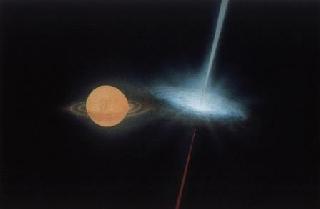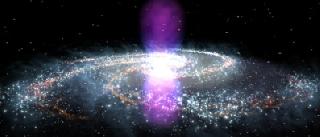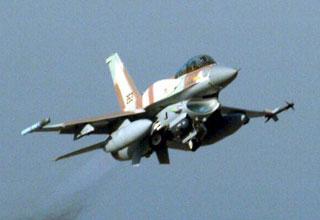
An artist's rendition of a microquasar in the x-ray binary system Circinus X-1. NASA photo
LONDON (PTI): Astronomers have discovered a small black hole, called a microquasar, weighing only as much as a star, which they claim would allow them to measure the power of black hole jets.
An international team, led by University of Strasbourg in France, which has spotted the microquasar, that shoots jets of radio-emitting particles into space, has concluded massive black holes are more powerful than previously thought.
Called S26, the black hole sits inside a regular galaxy called NGC 7793, which is 13M light-years away in the Southern constellation of Sculptor.
The team, led by Dr Manfred Pakull, has made the observations with CSIRO's Compact Array radio telescope near Narrabri in Australia. These show that S26 is a near-perfect analogue of much larger "radio galaxies" and "radio quasars".
Powerful radio galaxies and quasars are almost extinct today, but they dominated the early Universe, billions of years ago, like cosmic dinosaurs. They contain big black holes, billions of times more massive than Sun, and shoot out huge radio jets stretching millions of light-years into space.
Planetary scientists have been working for decades to understand how these black holes form their giant jets, and how much of the black hole's energy those jets transmit to the gas they travel through. That gas is raw material for forming stars and effects of jets on star formation are hotly debated.
"Measuring the power of black hole jets, and therefore their heating effect, is usually very difficult. With this unusual object, a bonsai radio quasar in our own backyard, we have a unique opportunity to study the energetics of the jets," said team member Roberto Soria of University College London, who carried out the radio observations.
Using their combined optical, X-ray and radio data, the scientists were able to determine how much of the jet's energy went into heating the gas around it, and how much went into making the jet glow at radio wavelengths.
They concluded that only about a thousandth of the energy went into creating the radio glow.
"This suggests that in bigger galaxies too the jets are about a thousand times more powerful than we estimated from their radio glow alone. That means that black hole jets can be both more powerful and more efficient than we thought, and that their heating effect on the galaxies they live in can be stronger," said Dr Tasso Tzioumis of CSIRO.
 Previous Article
Previous Article Next Article
Next Article









The Indian Air Force, in its flight trials evaluation report submitted before the Defence Ministry l..
view articleAn insight into the Medium Multi-Role Combat Aircraft competition...
view articleSky enthusiasts can now spot the International Space Station (ISS) commanded by Indian-American astr..
view article